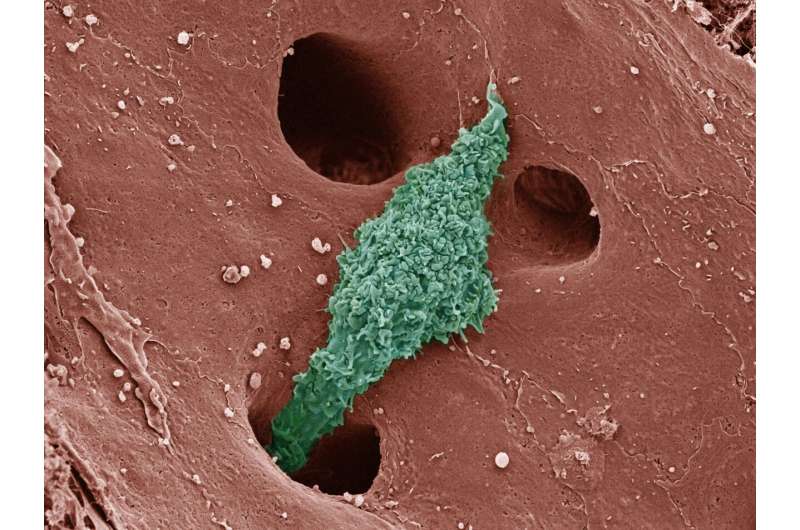This article has been reviewed according to Science X's editorial process and policies. Editors have highlighted the following attributes while ensuring the content's credibility:
fact-checked
peer-reviewed publication
trusted source
proofread
Macrophage mix helps determine rate and fate of fatty liver disease, study finds

Formerly known as nonalcoholic steatohepatitis, metabolic dysfunction-associated steatohepatitis (MASH) is an inflammatory disease characterized by liver scarring or fibrosis that progressively impairs liver function.
It is a major risk factor for cirrhosis and liver cancer. And because treatment options are limited, MASH is the second leading cause of liver transplants in the United States after cirrhosis caused by chronic hepatitis C infection.
A better understanding of the pathological processes that drive MASH is critical to creating effective treatments. In a new paper published in Proceedings of the National Academy of Sciences, a team of scientists from Sanford Burnham Prebys, the University of California San Diego School of Medicine and elsewhere describes the complex interplay between diseased liver cells and macrophages—a type of white blood cell whose jobs include killing and removing harmful cells and pathogens and helping to spur normal healing.
Debanjan Dhar, Ph.D., associate professor in the Cancer Genome and Epigenetics Program at Sanford Burnham Prebys, is senior author of the study. David Brenner, MD, president and CEO of Sanford Burnham Prebys, and Christopher Glass, MD, Ph.D., professor of cellular and molecular medicine at UC San Diego, are corresponding authors. Souradipta Ganguly, Ph.D., a postdoctoral research fellow at UC San Diego and Sanford Burnham Prebys, is the first author.
The researchers found that the heterogeneous mix of macrophages involved with MASH was different, depending on whether the disease was progressing or regressing. More importantly, they identified specific macrophage subpopulations that are critical for resolving MASH and liver fibrosis in which accumulating scar tissue impairs the organ's ability to function or repair itself. These fibrotic bands restrict blood flow, imperiling the entire organ.
"In MASH, Kupffer cells (a type of macrophage that resides in the liver) are lost and replaced by four distinct macrophage subpopulations. When the disease is in regression—that is, symptoms or severity are decreasing—two lipid associated macrophage subpopulations are dominant and express TREM2, a cell receptor that regulates cell survival, proliferation and anti-inflammatory responses," said Brenner.
"MASH regression occurs in the presence if TREM2+ macrophages. They not only restrict the progression of MASH-fibrosis, but effectively slow it and reduce inflammation. The absence of TREM2+ macrophages allows the disease to progress."
In early and moderate stages, MASH often produces no tell-tale symptoms, which is part of the reason it has reached epidemic proportions in the U.S. The American Liver Foundation estimates 80 to 100 million Americans have fatty liver disease, which—undiagnosed and untreated—progresses to nonalcoholic steatohepatitis, MASH, cirrhosis, liver cancer and death, often in combination with other conditions, such as obesity.
An estimated 1.5% to 6.5% of U.S. adults have MASH or are afflicted by the condition, and roughly 24% of adults have metabolic dysfunction-associated steatotic fatty liver disease, the starting point for MASH, cirrhosis and worse.
"Our findings suggest that lipid associated macrophages that express TREM2 and TREM2 are required both for the emergence of more liquid associated macrophages and for their reparative functions," said Dhar. "Effective degradation of scar tissue as a protective mechanism is mediated by TREM2, and the absence of TREM2+ macrophages not only disrupts the liver's ability to remove fibrotic tissue, but it also harms the entire immune response and healing process."
Going forward, the scientists say a TREM2 agonist—a drug or substance that mimics the function of TREM2—might be beneficial for MASH/fibrosis therapy and help spur MASH and fibrosis regression in patients also undergoing lifestyle modification, weight loss or bariatric surgery.
"There is only one approved treatment for MASH, and it was only approved earlier this year," said Glass. "Any opportunities to expand clinical options that benefit patients need to be thoroughly pursued because liver disease in this country—and around the world—is only getting worse."
Additional authors on the study include Sara Brin Rosenthal, Kei Ishizuka, Theresa V. Rohm, Naser Khader, Sebastiano Archilei, Jerrold M. Olefsky, Ariel E. Feldstein, Tatiana Kisseleva and Rohit Loomba, all at UC San Diego; Ty D. Troutman, UC San Diego and Cincinnati Children's Hospital Medical Center, and German Aleman Muench, Yasuyo Sano and Pejman Soroosh, Janssen Research & Development, San Diego.
More information: Souradipta Ganguly et al, Lipid-associated macrophages' promotion of fibrosis resolution during MASH regression requires TREM2, Proceedings of the National Academy of Sciences (2024). DOI: 10.1073/pnas.2405746121




















